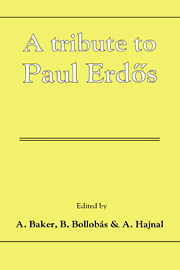Book contents
- Frontmatter
- Contents
- Preface
- List of contributors
- Acknowlegements
- Generating expanders from two permutations
- Sum-free subsets
- Is there a different proof of the Erdős-Rado theorem?
- Almost collinear triples among N points on the plane
- Hamilton cycles in random graphs of minimal degree at least k
- The circumference of a graph with a given minimal degree
- On arithmetic progressions in sums of sets of integers
- On graphs not containing prescribed induced subgraphs
- Partitions sans petits sommants
- A compact sequential space
- The critical parameter for connectedness of some random graphs
- Multiplicative functions on arithmetic progressions: III. The large moduli
- Locally finite groups of permutations of ℕ acting on l∞
- Hypergraph games and the chromatic number
- On arithmetic graphs associated with integral domains
- On the number of certain subgraphs of graphs without large cliques and independent subsets
- Sets of multiples of Behrend sequences
- A functional equation arising from mortality tables
- The differences between consecutive primes, IV
- On the cofinality of countable products of cardinal numbers
- On σ-centered posets
- A Galvin–Hajnal conjecture on uncountably chromatic graphs
- Necessary conditions for mean convergence of Hermite–Fejér interpolation
- On the Erdős–Fuchs theorems
- A tournament which is not finitely representable
- On the volume of the spheres covered by a random walk
- Special Lucas sequences, including the Fibonacci sequence, modulo a prime
- A remark on heights of subspaces
- Incompactness for chromatic numbers of graphs
- Graphs with no unfriendly partitions
- On the greatest prime factor of an arithmetical progression
- The probabilistic lens: Sperner, Turan and Bregman revisited
- On the mean convergence of derivatives of Lagrange interpolation
- Sur une question d'Erdős et Schinzel
- Large α-preserving sets in infinite α-connected graphs
- Some recent results on interpolation
- Partitioning the quadruples of topological spaces
- Some of my favourite unsolved problems
A compact sequential space
Published online by Cambridge University Press: 05 March 2012
- Frontmatter
- Contents
- Preface
- List of contributors
- Acknowlegements
- Generating expanders from two permutations
- Sum-free subsets
- Is there a different proof of the Erdős-Rado theorem?
- Almost collinear triples among N points on the plane
- Hamilton cycles in random graphs of minimal degree at least k
- The circumference of a graph with a given minimal degree
- On arithmetic progressions in sums of sets of integers
- On graphs not containing prescribed induced subgraphs
- Partitions sans petits sommants
- A compact sequential space
- The critical parameter for connectedness of some random graphs
- Multiplicative functions on arithmetic progressions: III. The large moduli
- Locally finite groups of permutations of ℕ acting on l∞
- Hypergraph games and the chromatic number
- On arithmetic graphs associated with integral domains
- On the number of certain subgraphs of graphs without large cliques and independent subsets
- Sets of multiples of Behrend sequences
- A functional equation arising from mortality tables
- The differences between consecutive primes, IV
- On the cofinality of countable products of cardinal numbers
- On σ-centered posets
- A Galvin–Hajnal conjecture on uncountably chromatic graphs
- Necessary conditions for mean convergence of Hermite–Fejér interpolation
- On the Erdős–Fuchs theorems
- A tournament which is not finitely representable
- On the volume of the spheres covered by a random walk
- Special Lucas sequences, including the Fibonacci sequence, modulo a prime
- A remark on heights of subspaces
- Incompactness for chromatic numbers of graphs
- Graphs with no unfriendly partitions
- On the greatest prime factor of an arithmetical progression
- The probabilistic lens: Sperner, Turan and Bregman revisited
- On the mean convergence of derivatives of Lagrange interpolation
- Sur une question d'Erdős et Schinzel
- Large α-preserving sets in infinite α-connected graphs
- Some recent results on interpolation
- Partitioning the quadruples of topological spaces
- Some of my favourite unsolved problems
Summary
Abstract
We give an Ostaszewski-type inductive construction of a locally countable locally compact space which is not α-realcompact but whose onepoint compactification is sequential. This answers a question of Nyikos. The essential ingredient is the use of the Balcar–Vojtas almost-disjoint refinement technique to guide the induction through continuum-many steps.
Introduction
A subset Y of a space X is sequentially closed if no sequence which is a subset of Y converges to a point outside of Y. A space is sequential if each sequentially closed subset is closed. There are not many absolute examples of ‘complicated’ compact sequential spaces in the literature. Furthermore, several important recent results of Balogh, Fremlin and Nyikos, which use Todorčević's ‘forcing positive partition relations’ techniques, show that such spaces cannot be too complicated. For example, they must contain points of first countability and no subspace can be mapped by a closed map onto ω1. The technique, roughly speaking, is to take a countably cpmplete maximal filter of closed sets of a subspace and diagonalize through it with an ω1 sequence that is homogeneous with respect to a certain partition. The homogeneity with respect to the partition guarantees that the sequence ends up being a free sequence in the sense of Arhangel'skii (see [1] or [6]). The upshot is that there cannot be too many countably complete maximal filters on subspaces.
- Type
- Chapter
- Information
- A Tribute to Paul Erdos , pp. 153 - 160Publisher: Cambridge University PressPrint publication year: 1990



